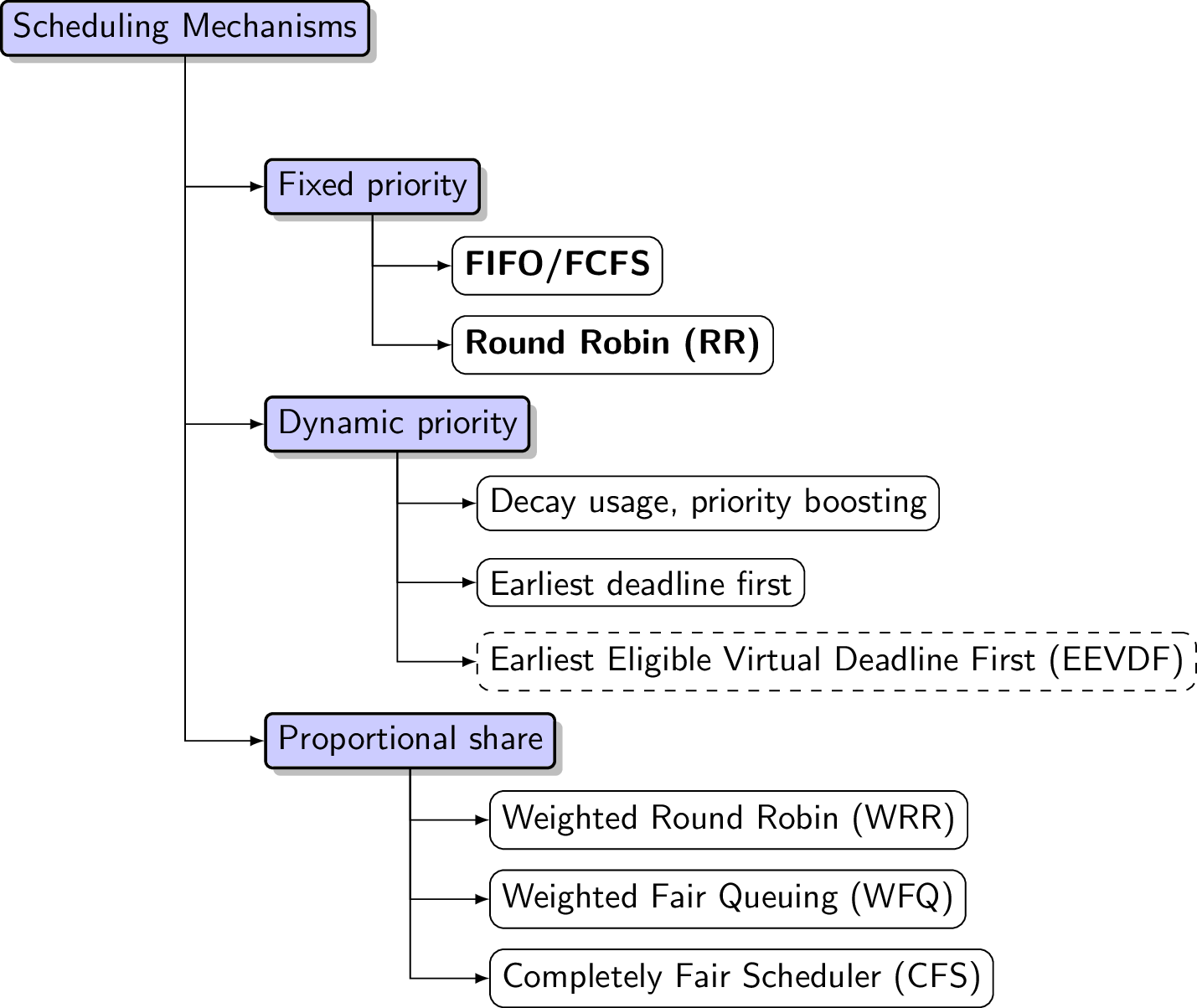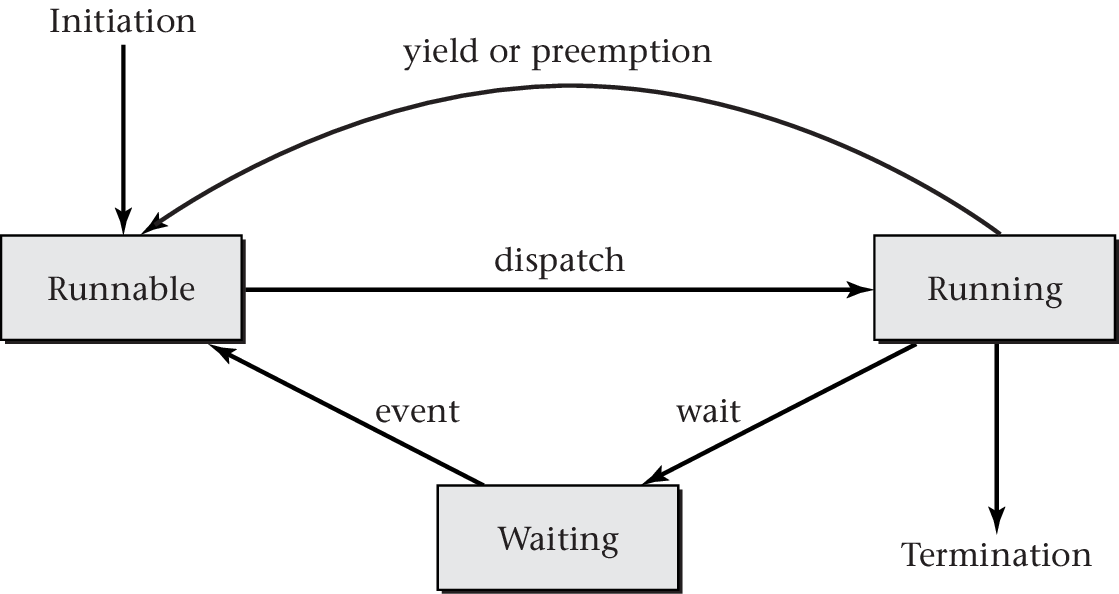Scheduling
(Usage hints for this presentation)
IT Systems, Summer Term 2025
Dr. Jens Lechtenbörger (License Information)
1. Introduction
1.1. Core Questions
- How does the OS manage the shared resource CPU? What goals are pursued?
- How does the OS distinguish threads that could run on the CPU from those that cannot (i.e., that are blocked)?
- How does the OS schedule threads for execution?
(Based on Chapter 3 of (Hailperin 2019))
1.1.1. CPU Scheduling
CPU scheduling
Figure © 2016 Julia Evans, all rights reserved; from julia's drawings. Displayed here with personal permission.
1.2. Learning Objectives
- Explain thread concept (continued)
- Including states and priorities
- Explain scheduling mechanisms and their goals
- Apply scheduling algorithms
- FCFS, Round Robin
1.3. Retrieval Practice
- Before you continue, answer the following; ideally, without
outside help.
- What is a process, what a thread, what multitasking?
- What does concurrency mean?
- How does it arise?
- What are blocking system calls?
- What is thread switching?
1.3.1. Thread Terminology
Agenda
2. Scheduling
2.1. CPU Scheduling
- With multitasking, lots of threads share resources
- Focus here: CPU
Scheduling (planning) and dispatching (allocation) of CPU via OS
Non-preemptive, e.g., FIFO scheduling
- Thread on CPU until termination, blocking, yield
Preemptive, e.g., Round Robin scheduling
- Typical case for desktop OSs
- Illusion of parallel executions, even on single-core CPU
- Among all threads, schedule and dispatch one, say T0
- Allow T0 to execute on CPU for some time, then preempt it
- Repeat, go to step (1)
(Similar decisions in operations management)
2.2. Sample Scheduling Goals
- Scheduling is hard; various goals with trade-offs
- Improvement for one goal may negatively affect others
- Performance
- Response time
- Time from thread start or interaction to useful reaction
- Throughput
- Number of completed threads (computations, jobs) per time unit
- More important for service providers than users
- Response time
- User control
- Resource allocation
- Mechanisms for urgency or importance, e.g., priorities
2.3. Thread Priorities
- Different OSs (and execution environments such as Java) treat
priorities differently
- E.g., numerical priority, so-called niceness value, deadline, …
- Upon thread creation, its priority can be specified (by the
programmer, with default value)
- Priority recorded in TCB
- Sometimes, administrator privileges are necessary for “high” priorities
- Also, OS tools may allow changing priorities at runtime
- Scheduling takes priorities into account
- Potentially with preemption
3. Thread States
3.1. OS Thread States
- Different OSs distinguish different sets of states; typically:
- Running: Thread(s) currently executing on CPU (cores)
- Runnable: Threads ready to perform computations
- Waiting or blocked: Threads waiting for some event to occur
- OS manages states via queues
(with suitable data structures)
- Run queue(s): Potentially per CPU core
- Containing runnable threads, input for scheduler
- Wait queue(s): Potentially per event (type)
- Containing waiting threads
- OS inserts running thread here upon blocking system call
- OS moves thread from here to run queue when event occurs
- Containing waiting threads
- Run queue(s): Potentially per CPU core
3.2. Thread State Transitions
3.3. Scheduling Vocabulary
4. Scheduling Mechanisms
4.1. Three Families of Schedulers
Families of schedulers
-
- E.g., FIFO, Round Robin
Dynamically adjusted thread priorities
- E.g., decay usage in Mac OS X, priority boosting in Windows
Controlling proportional shares of processing time
- E.g., weighted variants of other algorithms and Completely Fair
Scheduler (CFS) in Linux
- Fairness: All parties receive their share
- E.g., weighted variants of other algorithms and Completely Fair
Scheduler (CFS) in Linux
-

4.1.1. Notes on Scheduling
For scheduling with pen and paper, you need to know arrival times and service times for threads
- Arrival time: Point in time when thread created
- Service time: CPU time necessary to complete thread
- (For simplicity, blocking I/O is not considered; otherwise, you would also need to know frequency and duration of I/O operations)
OS does not know either ahead of time
- OS creates threads (so, arrival time is known), inserts them into necessary data structures
- When threads terminate, OS again participates
- Thus, OS can compute service time after the fact
- (Some scheduling algorithms require service time for scheduling decisions; then threads need to declare that upon start. Not considered here.)
4.2. Fixed-Priority Scheduling
Use fixed, numerical priority per thread
- Threads with higher priority preferred over others
- Smaller or higher numbers may indicate higher priority: OS dependent
Implementation alternatives
- Single queue ordered by priority
- Or one queue per priority
- OS schedules threads from highest-priority non-empty queue
Subsequent examples: FIFO and Round Robin
Beware!
- Starvation of low-priority threads possible
- Recall:
Starvation = continued denial of resource
- Here, low-priority threads do not receive resource CPU as long as threads with higher priority exist
- Threads with higher priority preferred over others
4.2.1. FIFO/FCFS Scheduling
- FIFO = First in, first out
- (= FCFS = first come, first served)
- Think of queue in supermarket
- Non-preemptive strategy: Run first thread until completed (or
yield or blocking)
- For threads of equal priority
4.2.2. Round Robin Scheduling
Key ingredients
- Time slice (quantum, q)
- Timer with interrupt, e.g., every 30ms
- Queue(s) for runnable threads
- Newly created thread inserted at end
Scheduling when (1) timer interrupt triggered or (2) thread ends, yields, or is blocked
Timer interrupt: Preempt running thread
- Move previously running thread to end of runnable queue (for its priority)
- Dispatch thread at head of queue (for highest priority) to CPU
- With new timer for full time slice
Thread ends, yields, or is blocked
- Cancel its timer, dispatch thread at head of queue (for full time slice)
- Time slice (quantum, q)
- Video tutorial in Learnweb
4.3. When to Schedule
- Unless explicitly specified otherwise, we consider preemptive
scheduling with time slices and priorities
- Threads may be removed from CPU before they are “done”
- Scheduling based on thread states, priorities, and time slices
- Sample events that may initiate scheduling
- Thread state(s) change
- E.g., thread created or finished, blocking system call, I/O finished; later: (un-) locking
- Thread priorities change
- Time slice runs out
- Thread state(s) change
- Sample events that may initiate scheduling
4.4. Self-Study Task for Scheduling
This task is available for self-study in Learnweb.
Perform Round Robin scheduling given the following situation:
| q=4 | Thread | Arrival Time | Service Time |
|---|---|---|---|
| T1 | 0 | 3 | |
| T2 | 1 | 6 | |
| T3 | 4 | 3 | |
| T4 | 9 | 6 | |
| T5 | 10 | 2 |
5. Conclusions
5.1. Summary
- OS performs scheduling for shared resources
- Focus here: CPU scheduling
- Subject to conflicting goals
- CPU scheduling based on thread states and priorities
- Basic approaches use fixed priorities
- Desktop OSs keep track of time on CPU, priorities, and events for more advanced scheduling
Bibliography
License Information
Source files are available on GitLab (check out embedded submodules) under free licenses. Icons of custom controls are by @fontawesome, released under CC BY 4.0.
Except where otherwise noted, the work “Scheduling”, © 2017-2025 Jens Lechtenbörger, is published under the Creative Commons license CC BY-SA 4.0.

